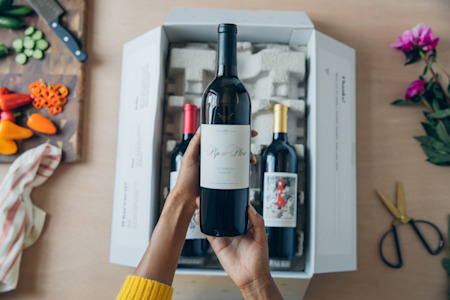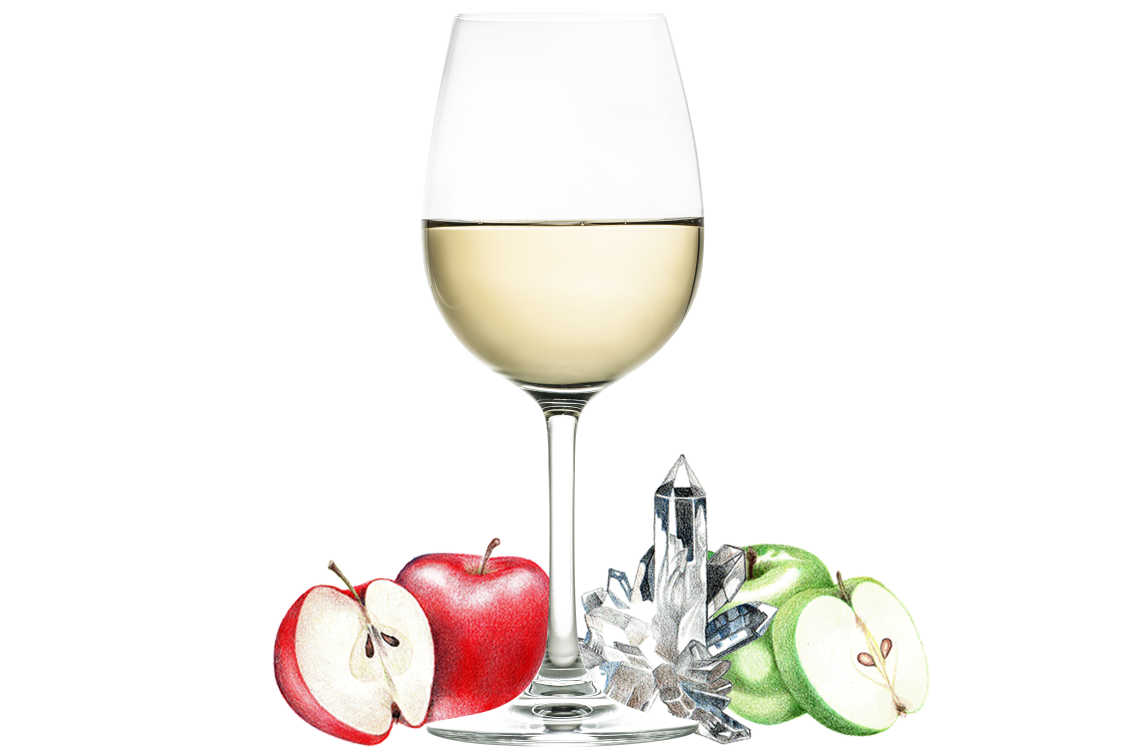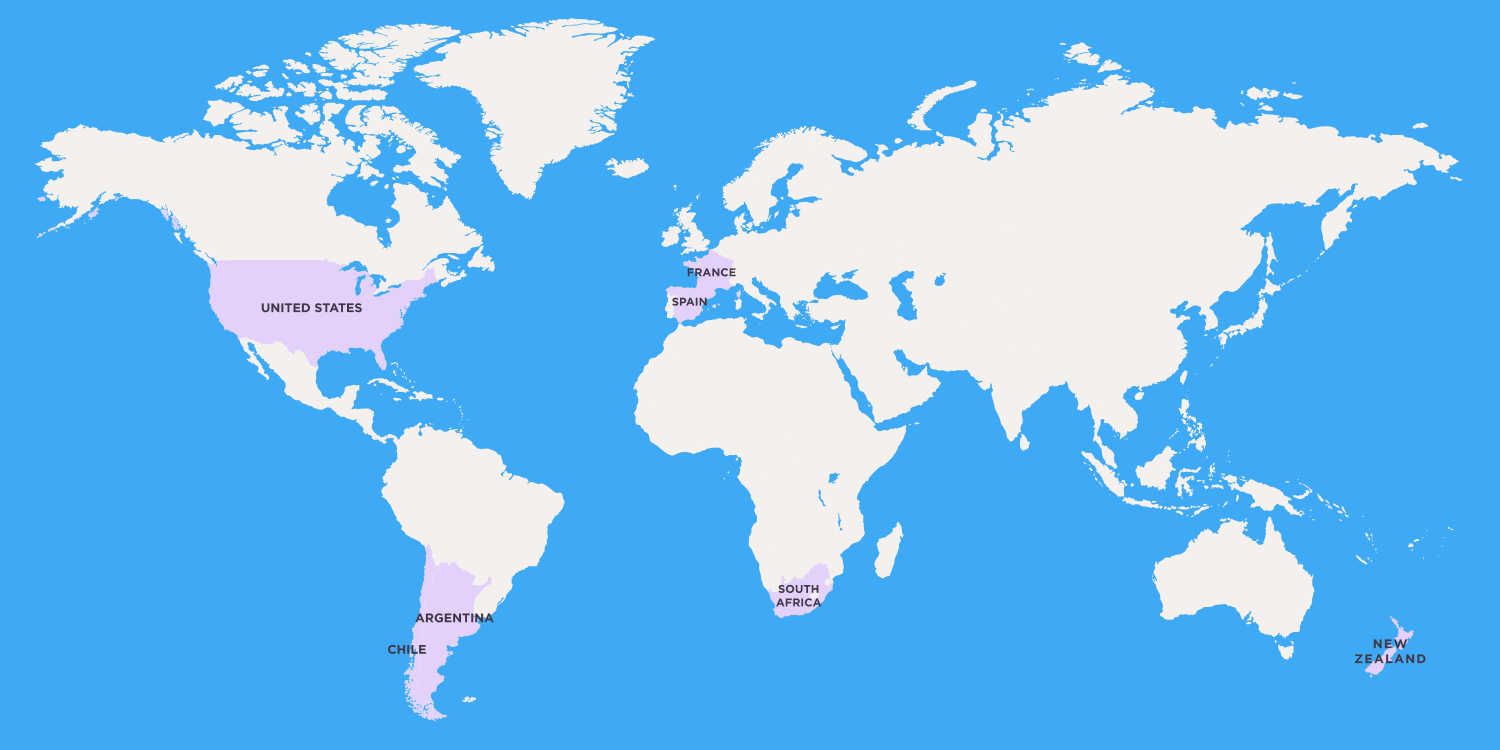Chenin Blanc
Learn more about Chenin Blanc, a grape that many critics call "the world's most versatile grape"
Chenin Blanc is a white grape varietal with incredible range. It's a versatile grape that is used to make dry wines, sweet wines, still wines, and sparkling wines all over the world. It makes light, one-note wines as easily as it makes rich, elegant wines, and it is even regularly used to make fortified wine. Many critics believe that it is the world's most versatile wine grape.
This high-acid grape has roots in the Loire Valley (where it is often called Pineau de la Loire) but can be found growing all over the world. It's especially popular in South Africa where it is known as "Steen."

Take Our Quiz Today
Get award-winning delicious wines from all over the world shipped straight to your door. Take the quiz to get the perfect pairings for your holiday season.
Take The Quiz TodayIN THIS ARTICLE:
Want personalized wines?
Get your first box of wines for $44.95 + free shipping.

History of Chenin Blanc
Chenin Blanc (pronounced shin-en blah-nk) was grown in the Loire Valley for centuries before it was officially documented in the 1490s. Descended from the wild Savagnin grape it is closely related to Cabernet Sauvignon, Sauvignon Blanc, and Cabernet Franc among many other varietals.
It was brought to South Africa as early as the 1650s by settlers from the Dutch East India Company.
For many centuries the grape languished and was uprooted or replaced by varietals that were easier to cultivate. While it was still grown around France (particularly in the Loire Valley) to make still and sparkling white wines, it was on a serious decline. But in the 1980s and 1990s Chenin Blanc experienced a massive resurgence in popularity in response to the growing desire for alternatives to the expensive Sauternes.
Fun Fact
Sparkling wine from France that is made outside of Champagne is referred to as "Crémant".
The sweet wines coming from the Loire Valley were the mix of high-quality and affordability needed to save Chenin Blanc from extinction. Wines from the Bonnezeaux, Coteaux du Layon, and Quarts de Chaume appellations gave Chenin a new lease on life.
Since then, the popularity of Chenin has grown all over the world and great examples can be found from it's home in the Loire to California, South Africa, and beyond.
What does Chenin Blanc taste like?
Chenin Blanc is a white wine that can be made in many different styles, but most examples feature fresh fruits and white flowers. Dry Chenin Blanc is crisp with notes of apple, guava, and quince playing off of strong minerality. Sweet Chenin retains the fresh qualities but adds in notes of honey, peaches, and barley as it ages.
Chenin Blanc Characteristics
Chenin Blanc is a thin-skinned white grape varietal that is known for having high-acidity and the ability to make wines that can age for many years. No matter the style, high-acidity is a hallmark of the Chenin Blanc grape.
Like the terroir-driven wines of Burgundy and Bordeaux, the weather shapes the way a Chenin Blanc vintage will turn out. Different soils provide different expressions, and it takes quite some time to ripen on the vine. "Old-vine" Chenin Blanc is preferable because it helps to produce grapes with more concentrated flavors.
The thin skins make the grape susceptible to noble rot (also known as botrytis cinerea) making it an ideal grape for dessert wines.
Many Loire winemakers ferment the Chenin Blanc at a warm temperature to reduce the tropical fruit flavors. They use no new oak, and only occasionally allow the grape to undergo malolactic fermentation.
New World Chenin Blancs are known for being fruit-forward with high acidity.
Chenin Blanc Nutritional Facts
The nutritional value in Chenin Blanc varies greatly depending on two main factors: alcohol and sugar. The more sugar present in a wine, the more carbohydrates.
The alcohol in Chenin Blanc varies depending on how ripe the grapes were when harvested, if the winemaker added extra sugar, and how long it was allowed to ferment. Dry Chenin Blanc wines are generally in the middle range for all of these categories, sweet Chenin Blanc wines range from medium to high-alcohol, and fortified Chenin Blancs are high in alcohol.
How to Serve and Store Chenin Blanc
Chenin Blanc is a grape variety with reach, but almost all dry Chenin Blanc wines are meant to be enjoyed fresh and should not be aged, although there are a few exceptions.
Demi-sec (semi-sweet) Chenin Blanc from a good producer needs about a decade before it is at its best to drink. The best sweet Chenin Blanc dessert wines can last for over a century. That being said, this only pertains to wines made by the best producers that have been stored professionally.
Serving Chenin Blanc can be done simply. The wine should start slightly lower than room temperature, and we would recommend popping it in the refrigerator an hour or two before serving. This is all personal preference. Enjoy your wine how you like it.
To open you will need a traditional corkscrew.
If you are storing Chenin Blanc, it should be in a cool place that does not receive direct sunlight, and preferably in a wine refrigerator or cellar. 55 degrees Fahrenheit is the median temperature wine should be stored if you wish to age the bottles. What matters most is consistency. Do not store your Chenin Blanc in a place that receives direct sunlight, heat, or too much humidity and remember to enjoy it while it's fresh.
What to Pair with Chenin Blanc
Pairing wine has some general rules, but we think the most important rule is to drink Chenin Blanc with the food you like. The style of Chenin Blanc will help direct pairings, and dry examples pair excellently with lightly grilled fish or on their own. Sweet Chenin Blanc can cut through the richness of pâté, foie gras, or blue cheese wonderfully, and dry Chenin Blanc can supplement the flavors of many fish dishes as well as roasted chicken.
Chenin Blanc Wine Regions Around the World
France:
The Loire Valley is the home of the Chenin Blanc grape, with the Middle Loire around Anjou-Saumur and Touraine representing the most plantings.
The versatility of Chenin Blanc is highly prized and can be clearly seen across appellations in the Loire. For example, Vouvray and Montlouis are two small villages that sit directly across the Loire river from one another and present contrasting views winemaking style of each vintage. Montlouis is typically dry, Vouvray is typically sweet, but the weather ultimately dictates what both will end up producing. In regions where there is less inclement weather like Savennières the winemakers focus on dry Chenin Blanc.
Chenin Blanc is also used alongside Chardonnay and Cabernet Franc as one of the grapes in Crémant de Loire.
Fun Fact
Vouvray's Domaine Huet is famous for producing a demi-sec (semi-dry wine) almost every year that can age half a century.
South Africa:
South Africa produces amazing old vine Chenin Blancs which are commonly referred to as "Steen." Examples from Stellenbosch and Swartland are what made South African Chenin Blanc famous.
Chenin Blanc is the most grown grape in South Africa, and for many years it was used almost exclusively to make brandy.
United States:
There is a lot of Chenin Blanc grown in the United States. The main concentration of Chenin Blanc comes from the Central Valley of California, and especially the Clarksburg region, but Napa Valley and warmer appellations have the occasional standout Chenin Blanc.
Oregon produces good Chenin Blanc as well, but some of the most interesting wines that use the grape come from vineyards on Long Island in New York.
Chenin Blanc Growing Elsewhere:
Chile, Spain, Argentina, and New Zealand all grow Chenin Blanc, with many regions that have the potential to produce great wines, if the plantings can increase.
IN THIS ARTICLE
Want personalized wines?
Get your first box of wines for $44.95 + free shipping.


WinePrint™ by Firstleaf
Are you looking to learn more about your wine preferences? Check out our Wine Print for an in-depth look at your personal tasting profile. Discover your favorite wines, varietals, regions, and tasting notes and get personalized recommendations wherever you are.
Learn More
